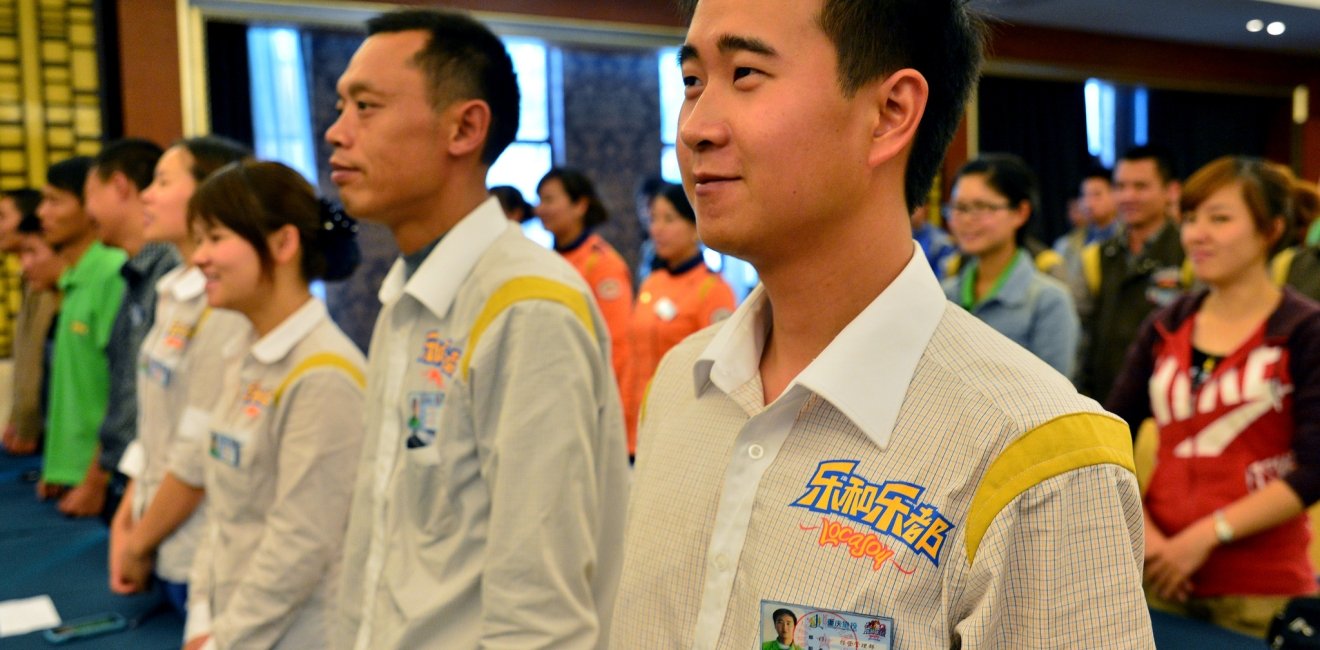The Terrible Amusement Park that Explains Chongqing’s Economic Miracle
With China's cities drowning in debt, one megalopolis is getting its books in order by selling off trained dolphins, Australian iron ore, and life insurance companies.
With China's cities drowning in debt, one megalopolis is getting its books in order by selling off trained dolphins, Australian iron ore, and life insurance companies.

Locajoy, an amusement park a two-hour drive from downtown Chongqing, has seen better days. When I visited in November, the walls of the dolphin enclosure — where dolphins perform daily with a chimpanzee in a yellow Hawaiian shirt and a handler dressed as Capt. Jack Sparrow — were stained brown with what looked like giant cigarette burns. Brightly colored, animal-shaped Fiberglass floats, built for parades through the park, had been bleached white in parts by the sun, and some had such large holes that you could see inside their empty shell. Meanwhile, thrill-seekers on the miniature Splash Mountain splashed their way into a stagnant brown creek.
The park is a tough sell. In 2013, the most recent period for which numbers are available, Locajoy — the Chinese name, Leheledou, translates as “happiness for all” — made only $320 in profit, a little more than what it would cost to take a family of four to the recently opened Shanghai Disney Resort. Locajoy’s parent company fared only marginally better. It managed to turn a profit that year, but its businesses hemorrhaged $150 million in cash. It’s now trying to get out of the fun-park industry and is looking for buyers. What makes Locajoy different from a mediocre business elsewhere is that it is owned by the Chongqing Tourism Investment Group, a state company wholly owned by the Chongqing municipal government.
Since the end of 2013, Chongqing — a city of 33 million people in China’s southwest known for its spicy food and political scandals— has been quietly selling off equity in city-owned companies at a time when state-sector reform, announced to much fanfare by President Xi Jinping three years ago, had otherwise seemed to have stalled amid bureaucratic infighting. In a country that often trials economic reforms at a local or regional level before rolling them out nationwide, that suggests there might be hope for Xi’s reform agenda. Equally as important, Chongqing’s experience also suggests a solution to one of China’s other intractable economic problems: local government debt.
China’s state-owned companies are the laggards of the economy. They are about a third as efficient as private-sector companies — as measured by return on assets — despite being supported with a host of subsidies and other perks. State companies account for only about a quarter of economic output, but they dominate some of the most important industries, like telecommunications and banking. In November 2013, Xi called for what he termed “mixed-ownership” reform that would lift the efficiency and effectiveness of state-owned companies by diluting government holdings. Governments would sell down their shares to other state companies, pension funds, private equity investors, as well as private and foreign companies in the hope that a greater range of shareholders would unleash companies’ entrepreneurial spirits. If anything, however, reform has gone backward.
In June, Beijing ruled that the Chinese Communist Party must have a say in all major business decisions taken by state companies. Meanwhile, Beijing seems to be moving in the opposite direction: In December 2015, it merged two of its shipping giants, followed shortly by its two leading train makers, creating even bigger national champions.
Chongqing would gain little, if anything, from retaining ownership over the type of companies it’s been selling.
What Chongqing is doing is found at the other end of the strategic spectrum. Chongqing would gain little, if anything, from retaining ownership over the type of companies it’s been selling. Equity in fun parks and baijiu distribution companies have been put on the block. Some companies have been big — being sold for billions of yuan — and some small, but regardless of size they haven’t occupied the economy’s commanding heights. As to whether Chongqing’s equity sales have resulted in more efficient companies, there’s no way of telling as of yet. But it may do wonders for the city’s finances.
Despite repeated efforts by Beijing to rein in debt, local government spending has continued to balloon in recent years. According to data compiled by China Business News based on disclosures by local governments, China’s provinces — including Chongqing, a municipality with the administrative rank of a province — on average saw a 47 percent increase in debt between mid-2013 (the last time there was a nationwide audit) and the end of 2015. The increase varied widely, with the far western region of Ningxia posting a 127 percent increase, while its neighbor Gansu increased by only 40 percent. Chongqing saw its debt burden decline by 4.6 percent, or about $2.4 billion on debts of about $52.6 billion, making it one of only two provinces that reduced its deficit.
That’s all the more significant given that Chongqing has the fastest-growing provincial economy in China, expanding 11 percent in 2015 compared with 6.9 percent for the country as a whole. None of the usual economic indicators explain how it has managed this twin feat of record growth and reduced debt. It hasn’t changed its growth model: The city is heavily dependent on investment, with fixed-asset investment (money spent on capital goods like machinery and buildings) growing by more than 17 percent in 2015. The most important tool available to local governments to fund investment and pay down debt is selling land, but Chongqing’s land sales fell 7 percent in 2015. Local governments also are trying to encourage private investment in infrastructure, thereby lessening the state’s funding burden, but Chongqing has arranged only a handful of so-called public-private partnerships, far less than most provinces.
That leaves state-owned equity sales. In his 2016 annual work report — a kind of State of the City address — Mayor Huang Qifan, the city’s second in command, said that in the course of pursuing mixed-ownership reform, Chongqing sold about $10.6 billion worth of equity in state companies the previous year. In his 2015 report, he said the city sold $17.4 billion worth of equity in 2014. That’s equivalent to 44 percent of land sales in 2015 and 68 percent a year earlier.
Economists have said for years that China’s local debt problems are manageable because local governments own a huge amount of assets: land, forests, mining resources, and, most importantly, equity in companies.
Nationwide, local governments own about 100,000 companies, with assets that could be worth about $7.5 trillion.
Nationwide, local governments own about 100,000 companies, with assets that could be worth about $7.5 trillion. Chongqing alone has $375.4 billion worth of state-owned assets, seven times its debt. The difficulty has always been that meaningfully large assets sales were off-limits.
Chongqing’s efforts seem to have really kicked into gear in the second half of 2014, when the Chongqing State-owned Assets Supervision and Administration Commission (SASAC) — the agency responsible for regulating state companies — posted on its website a spreadsheet of 110 state companies, assets, and projects in which it was willing to sell equity and included contact names and phone numbers for the SASAC officials responsible for selling them. If you were interested in Locajoy, which was valued at about $300 million, you could contact Luo Rui, who would also entertain joint venture and leasing offers. It was an eclectic list that included eight live-aboard riverboats that cruise the Three Gorges, a popular tourist destination; a 10,000-ton electrolytic copper converter; and an iron-ore mine in western Australia — just the sort of companies a provincial government has little business being involved in.
The scope of assets for sale has expanded well beyond the list. The Chongqing United Assets and Equity Exchange — an electronic auction house that sells everything from cars to mining rights — said it sold $5.5 billion of state assets in 2014, up 80 percent over the year before. In the first half of 2015 alone, it sold $4.5 billion worth. Most of those deals were tiny, like the automotive design company that the Chongqing No. 1 Middle School sold for $105,000 to a privately held Guangzhou-based industrial design company. But the exchange has also been the forum for the single-biggest deal thus far, the sale by two of Chongqing’s largest local government financing vehicles — both wholly owned by Chongqing SASAC — of their combined 50 percent stake in a local life insurance company to Evergrande Life for $585.6 million. (Evergrande Life is the insurance arm of the major real estate developer Evergrande Group.)
Not all of the buyers have been private companies. State companies did some of the other big deals: China Life — the country’s biggest state-owned life insurance company — paid city-owned utility Chongqing Water about $90 million for a 24 percent stake in Chongqing International Trust, a financial institution. And China South Industries Group, a central government-owned company involved in cars and military equipment, took a 45 percent stake in an auto-leasing company for $170 million, buying it from Chongqing Rural Commercial Bank and Yufu Asset Management, both of which are Chongqing city-owned companies.
Beijing still has to decide whether Chongqing’s experience is worth rolling out nationwide. Relative to China’s provinces, Chongqing is very small and Beijing regards Huang as a safe pair of hands when it comes to economic reform. Applying this to other provinces is more risky. When the central government published its long awaited state-sector reform blueprint in September, it was notable for just how jittery Beijing is about state assets being sold off too cheaply. That’s what brought state sector reform to a shuddering halt a little more than a decade ago, amid a public backlash against asset stripping and the perception that insiders were getting sweetheart deals. With cash-strapped local governments desperate to pay down their debts, there’s no guarantee that it won’t happen again.
Of course, part of the problem is that it’s difficult to set a price for money-losing companies. For Locajoy, that might prove particularly difficult because there isn’t really a market price for performing dolphins, or for the dancing bears at the in-house circus. But the city of Chongqing’s willingness to try to find a price has put the amusement park at the cutting edge of one of China’s most anticipated economic reforms, one that could have a meaningful impact on the nation’s economic health.
This article was originally published at Foreign Policy


The Kissinger Institute works to ensure that China policy serves American long-term interests and is founded in understanding of historical and cultural factors in bilateral relations and in accurate assessment of the aspirations of China’s government and people. Read more


